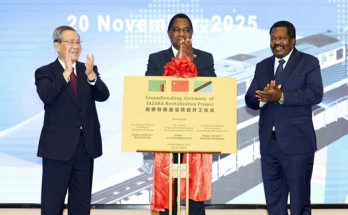
China’s Belt and Road Initiative (BRI) has arrived in Sub-Saharan Africa, bringing the prospect of significant capital flows, improved trading opportunities and economic growth. But what impact will it have on the region’s real estate markets?
A new Silk Road
Known initially as “One Belt, One Road,” the initiative features a US$900 billion programme of infrastructure projects, along with efforts to enhance economic cooperation along key international trade routes. Announced in 2013, it includes the Silk Road Economic Belt through Central Asia and the Middle East to Europe, and a 21st Century Maritime Silk Road across the Indian Ocean to embrace Sub-Saharan Africa.
While the BRI is a somewhat nebulous initiative – often bundling an array of existing or mooted projects under one banner – the aim is to improve China’s global connectivity, open up international investment opportunities, boost exports and fuel the country’s slowing economic engine.
“The BRI is not just about developing infrastructure,” explains Jeremy Kelly, Director in Global Research with JLL. “It is also about extending China’s soft power and influence across the globe with the export of the country’s capital, corporations, technology, innovation and services.”
Investing in infrastructure
By opening up new sources of funding, the BRI is enabling Chinese companies to undertake higher risk investments in higher risk locations, notes Kelly. In Sub-Saharan Africa, the initiative has focused primarily on infrastructure development, most notably regional transportation projects in a bid to connect communities, enable trade and foster economic growth.
In West Africa, much of the focus appears to be on Nigeria, says Kelly. For example, the Lagos-Kano standard gauge railway is being constructed in tranches, with the first sections now completed. Construction of a 1,400 km coastal railway from Lagos to Calabar is expected to commence in 2017.
Most BRI-related activity to date though has taken place in East Africa.
Kenya
Nairobi-Mombasa railway – The US$3.8 billion railway project, which is 90 percent funded by the Export-Import (Exim) Bank of China, aims to boost connectivity between Kenya’s two main economic hubs. The line, which was inaugurated in May 2017, will also help open up the big logistics developments to the northeast of Nairobi, such as ALP’s project at Tatu City. A second phase is planned to extend the railway to Uganda, and subsequently South Sudan, Rwanda and Burundi. Funding is in place and the work is due to start next year.
Lamu Port in North Kenya – Construction of the first phase of what will be East Africa’s largest port is underway, with full completion expected in 2020. The new port being built by China Communications Construction Company is part of the Lamu Port-South Sudan-Ethiopia Transport Corridor (LAPSSET), which will eventually connect to Ethiopia and Uganda.
Together, the railway and port will boost Nairobi’s logistics sector over the medium to long term, particularly if the region’s other landlocked countries are connected to them.
Ethiopia-Djibouti
Ethiopia-Djibouti railway – The 750 km railway, completed in 2017 connects Ethiopia’s capital, Addis Ababa, to the port in Djibouti, which serves as the main hub for imports from and exports to Ethiopia. The US$4.2 billion project was built by China Railway Group and China Civil Engineering Construction, with funding from China’s Exim Bank, Development Bank of China, and the Industrial and Commercial Bank of China.
Tanzania
Regional railway – In July 2016, Tanzania signed a US$7.6 billion loan agreement with China’s Exim Bank to finance construction of a railway that will link the country with neighbouring Uganda, Rwanda, Burundi and the Democratic Republic of Congo.
Bagomoyo project – This is a huge joint project between Tanzania, China Merchant Holding International and Oman’s State General Reserve Fund. The project will create a Special Economic Zone area, with construction of one of the biggest ports in Africa along with an adjacent industrial park.
BRI impact on real estate
Interest in Sub-Saharan Africa has been growing for several years, particularly from corporations keen to tap into Africa’s growth opportunities and increase their presence. On a global scale, the numbers have so far been relatively small, but momentum is strong and BRI should further boost real estate market activity is some African countries. Kenya, for example, has already seen significant investment in areas such as logistics.
Logistics and transport costs in Sub-Saharan Africa remain the highest in the world, with the World Bank estimating approximately 40 percent of consumer prices are made up of transport and related costs. As more integrated logistics hubs, and better transport improve and lower the cost of goods distribution, it should prompt greater consumer expenditure, further stimulate local commercial activity, and boost overall economic growth in the long term. This will feed through into increasing demand for modern real estate.
“The greatest impacts on real estate markets will be in cities such as Nairobi, Addis Ababa and Lagos, whose economies will benefit most from the improvements in connectivity,” states Kelly.
What the BRI means for investors
With the real estate investment opportunities from the BRI limited at this stage, investors will continue to be selective about the SSA markets in which they chose to invest. Assets in growing economies with clear income streams will offer the best risk-reward profile, and are likely to trade at a significant premium. Improvements in infrastructure, as a result of initiatives such as the BRI, offer a degree of optionality for investors over the longer term, though they are difficult to price in the short term.
“While infrastructure may be upgraded as part of the BRI, it needs to be matched by further improvements in governance and transparency for the real estate markets in Sub-Saharan Africa to become more attractive to investors,” says Lucy Githinji, from JLL’s Sub-Saharan African team. “Instead, investors should monitor the SSA markets that are already relatively well-developed – i.e. cities such as Nairobi – whose more diverse economies are likely to benefit from the infrastructure improvements over the medium term.”



